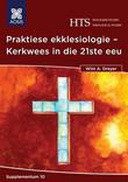Explore

Praktiese ekklesiologie – Kerkwees in die 21ste eeu
Wim A. Dreyer
2016
In die boek word voorgestel dat bestaande kerklike- en opleidingsmodelle in die Suid-Afrikaanse Hervormde ekklesiastiese kringe, ‘n ingrypende transformasie behoort te ondergaan. Dit neem die teologiese debat, veral in die ekklesiologie, tot die volgende vlak, en bepleit nuwe maniere om aan die geloof in kerklike praktyk, uiting te gee. Die boek verskaf ‘n uitdagende strategiese visie wat die kerklike uitdagings van die een-en-twintigste eeu ernstig opneem. Die boek sal nie net vir teoloë in die akademie tot voordeel wees nie, maar ook vir kerkleiers. Eerstens is daar ‘n situasie-ontleding gedoen wat op die omstandighede en die sosiale status van hoofstroomkerke in die een-en-twintigste eeu, gekonsentreer het. Huidige probleme en struikelblokke is geïdentifiseer. Dit kan hoofsaaklik toegeskryf word aan die sekularisasie en na-Christelike tendense van die tydperk na die twee wêreldoorloë. Tweedens word voorgestel dat die vernuwing van en die broodnodige wysigings aan die strukture van die Suid-Afrikaanse Protestantse geloofgemeenskape in ‘n postmoderne, postliberale en postkoloniale verband, op ‘n verantwoordelike manier gedoen word. Die gesag van die Skrif en die geloofsbelydenisse van hierdie kerke is die grondslag vir ‘n sinvolle hernuwing. In die boek word gesprek gevoer met die tersaaklike, bestaande literatuur soos wat dit sy missionale benadering om vandag kerk in die wêreld te wees, ontwikkel. Die ondersoek is deeglik, die bewysvoering is betroubaar en die boek lewer ‘n oorspronklike en gedagteprikkelende bydrae op dié gebied. Die bydrae sluit in Bybelse perspektiewe en dié van kerklike gemeenskappe, ‘n historiese oorsig van die ontwikkeling en agteruitgang van die hoofstroomkerke, insigte met betrekking tot die beskikbare empiriese gegewens en strategieë vir die toekoms. Die werk getuig van ‘n deeglike metodologie en ’n sterk teoretiese grondslag. Literatuur van verskeie dele van die wêreld is gebruik, wat breedte en diepte aan die werk verleen. Die outeur vertoon ‘n indrukwekkende vermoë deur die bevindinge van talryke gebiede te integreer.
This book is included in DOAB.
Why read this book? Have your say.
You must be logged in to comment.
